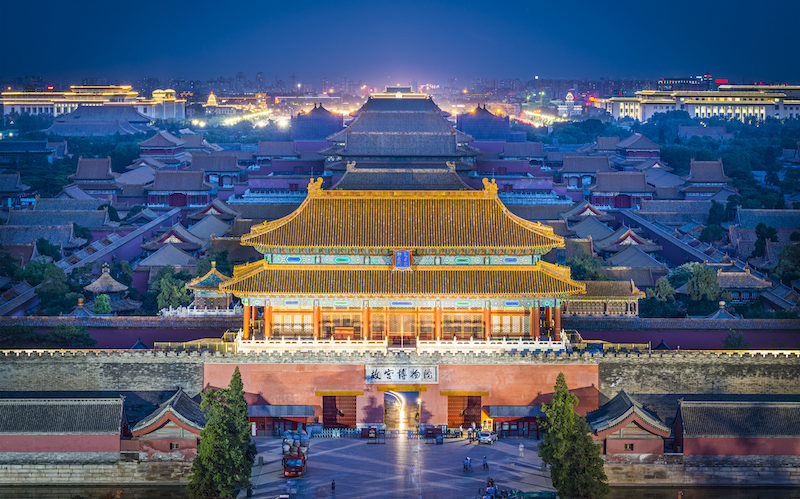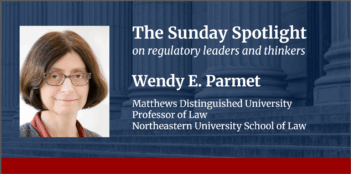
China’s approach to regulatory law has both helped and hindered the government’s response to COVID-19.
China’s response to the outbreak of the novel coronavirus reflects characteristic weaknesses—as well as strengths—of the Chinese administrative state.
The COVID-19 pandemic began with regulatory shortcomings in China. The disease appears to have crossed over to humans at a market in Wuhan where merchants sold wild animals for human consumption. Chinese authorities shut down the Wuhan Huanan Seafood Wholesale Market—the place where many suspect the virus first transmitted to humans—on January 1, 2020, after the outbreak had begun.
Public health experts recognized the threats posed by such markets well before the current pandemic. The SARS epidemic in 2003, for example, originated in a similar manner to COVID-19, as did other infectious diseases emanating from China in recent years. Although China’s post-SARS reforms addressed reporting of disease outbreaks and government response, they did less to mitigate the underlying risk. A principal relevant law, the Wildlife Protection Law, still permitted trading and consumption of species that state authorities have not declared to be rare or endangered and under “priority protection.”
Only after the COVID-19 outbreak threatened to spread across China amid the Chinese New Year’s travel season did authorities announce sweeping restrictions.
On January 26, three days after locking down the epicenter of Wuhan, the State Administration for Market Regulation, the Ministry of Agriculture and Rural Affairs, and the National Forestry and Grassland Administration issued a joint directive banning the transportation and trading of wild animals for the duration of the epidemic.
On February 24, the National People’s Congress Standing Committee—which has wide-ranging law-making powers—issued a “Decision on Completely Prohibiting Illegal Trade in Wildlife, Eliminating the Bad Habit of Indiscriminately Eating Wild Animals, and Earnestly Ensuring the Life, Health, and Safety of the People.” The Decision banned hunting, trading, transportation, and use, for human consumption, of wild species of land animals. It also called for heavy penalties for violations of existing law and directed governments at all levels to increase supervision, investigation, and punishment of the prohibited activities. Some local governments issued even stricter regulations.
The National People’s Congress also has fast-tracked amendments to public health and safety laws, including an amendment to the Wildlife Protection Law that will make the recent restrictions on the trade and consumption of wildlife permanent. The revised laws are likely, however, to continue to permit consumption of wild animals as part of traditional Chinese medicine—a loophole, critics point out, that could permit problematic trade to continue relatively unabated.
A more ambitious law to address the sources of COVID-19 would have faced challenges endemic to regulation in China. The saying zhixing nan—“implementation is hard”—captures a pervasive problem that is especially serious for public health-protecting measures that address behavior that is widely dispersed among many actors or vital to local livelihoods. Past examples of such laws include those that mandate shutting down polluting small factories or targeted small-scale dairy farmers’ malnutrition-causing dilution of milk (prompting some farmers to add prohibited melamine to milk to fool government-mandated tests and, in turn, leading to tens of thousands of serious injuries to poisoned infants in 2008). Analogous difficulties face China’s moves to address the COVID-19 crisis through laws that would close, or severely restrict, disease-spreading wild animal markets. Indeed, the challenges of implementation are all the more serious because these measures seek to ban a popular activity: wild animal consumption.
Without reliable and effective preemptive enforcement of rules to prevent public health crises, authorities often rely on harsh, reactive measures, such as the punishments prescribed for violators of the COVID-19-driven prohibitions on trade in wildlife and similar measures undertaken during the SARS crisis. Such sanctions reach few people but their severity and publicity attempt to deter many more. The Chinese government supplements this approach with publicity campaigns in state-controlled media to promote desired behavior and—if the crisis is serious enough—after-the-fact law reforms which—unfortunately—often face implementation difficulties.
The more notable regulatory dysfunction in China’s handling of COVID-19 came later, in the response to the outbreak in Wuhan. After SARS, China amended its Law on the Prevention and Treatment of Infectious Diseases, created a national rapid direct reporting system for contagious diseases, and, a few years later, adopted an Emergency Response Law. These reforms aimed to address shortcomings revealed during the SARS epidemic including: avoiding concealment of early information by government officials and others; ensuring prompt reporting of potentially serious events to higher levels of the government, including the public health bureaucracy; disseminating timely and accurate information to the public; and mobilizing the full range of state and societal resources to address public health emergencies. Nonetheless, familiar problems resurfaced in the COVID-19 crisis.
Information about the disease and its seriousness was not promptly and effectively reported to higher levels of the government or the public. Indeed, some local officials suppressed early information. Assigning a date when authorities “should have known” of the dangerous and communicable illness is a tricky business, but at least a few crucial weeks—and possibly a month—passed before officials sounded the alarm. Like surgeon Jiang Yanyong who publicized the government’s cover-up of SARS, ophthalmologist Li Wenliang reported in a message to a WeChat group—that spread more broadly—on a surging novel respiratory ailment in Wuhan that the government and media were not discussing.
Within days, local authorities moved to silence Li and chill other would-be sources of information, sometimes invoking China’s vague and flexible rules against spreading “rumors” generally and in the specific context of a public health crisis.
Although the details remain uncertain and contested, it appears that local officials, working together with hospital administrators, kept higher level officials in the dark for a brief but critical period. Although we do not know individual officials’ motivations, longstanding pathologies of Chinese governance gave them incentives to act as they apparently did. When local-level officials in China grapple with circumstances that look like failures of governance or divergence from policy, they often face a double-or-nothing bet. They can try to keep the situation quiet in the hope that they can handle it without the career-damaging effects that would occur if higher authorities learn of the problem. But, if the problem becomes unmanageable and known to higher-ups, the lower-level official faces much graver consequences for both failing at governance and attempting to cover up the failure. The timing of the COVID-19 outbreak in Wuhan—on the eve of the politically high-profile annual plenary meeting of the local people’s congress—sharpened this dilemma for officials.
Incentives to keep higher-ups in the dark are ubiquitous in hierarchical systems, but they have been especially serious in modern China and have resurged with the Xi-era emphasis on top-down rule under a venerated leader. Although four decades of legal and institutional reforms have brought much improvement, they have not erased a dangerous dynamic that reached its lowest point in the Great Leap Forward at the end of the 1950s. During that period, local cadres misrepresented dismal harvests, leaving national leaders to believe that their dysfunctional policies for increasing output were working. This malignant feedback loop led to massive extraction of food from peasants and, in turn, mass starvation.
The demerits and termination of officials judged to have botched the handling of SARS and COVID-19 show the persistence of the incentives officials have to make the risky bet. Amid COVID-19, the ousters included the party chiefs in Wuhan and the surrounding province as well as lower-level officials in Wuhan and many other affected cities.
What analysts of Chinese politics call “dual rule,” and the more ubiquitous phenomenon of “bureaucratic fragmentation,” compound such problems and seem to have been at play in the COVID-19 crisis. Local-level public health officials, charged with investigating and reporting potential epidemics, answer not only to their superiors in a hierarchical structure that reaches to ministerial levels in Beijing, but also to their same-level provincial or local governments where the incentives to conceal and deny are potent. China’s notoriously siloed bureaucracies impede effective monitoring of, and formulating early responses to, complex public health crises such as COVID-19, which require coordination across government entities with different core responsibilities.
Withholding information from the public—especially by national-level authorities—reflects other problematic features of Chinese governance. Officials may have attempted to control the information flow to avoid panicking the public, but ended up making matters worse. China’s information environment—which includes a strictly controlled institutional media and restricted but often rumor-filled social media—heightened this risk because citizens inferred that the situation may be more dire than what official sources revealed.
Despite the profound retrenchment of the party-state’s reach during the post-Mao era, the current regime faces the “Spider man principle” of authoritarian rule. Because it claims great power over society, it also bears great responsibility and faces public blame when it fails to keep citizens safe or falls short in governing. This problem has become more acute under General Secretary and President Xi Jinping, who has recentralized power to the national level and into his own hands, earning himself the moniker “Chairman of Everything.”
On the other hand, significant aspects of China’s response to the COVID-19 outbreak reflect the system’s characteristic—if at times heavy-handed—strengths. Once the relevant information reached higher levels, and upper-level leaders recognized its significance, there was little or no room for the politics of denying science and expertise, or for insistence upon local autonomy or responsibility, or notions of limits to proper roles for the state. Authorities employed their formidable capacity to suspend inter-city travel, wall off neighborhoods, and restrict severely entry and exit from buildings. Such moves started in Wuhan but were widespread, and elements of this line of attack returned following an early June 2020 outbreak at a Beijing wholesale food market.
Old-school labor-intensive monitoring by neighborhood residents’ committees functioned symbiotically with the high-tech tools of China’s surveillance state. They reportedly mobilized thousands of doctors and medical staff from around the country and built makeshift hospitals to cope with the influx of cases in Wuhan and elsewhere.
In less hard-hit cities and as closed-down areas reopened, the government deployed formidable resources for testing and tracing. China’s distinctive combination of a highly digitized and online urban society, pervasive network of cameras, sensors, and facial recognition technology, and weak constraints from privacy concerns and civil liberties created robust—if, in the official accounts, exaggerated—means for combatting the virus’s spread or re-eruption. Tools included taking temperatures at countless locations, scanning quick response codes to check the “red, yellow, or green” health status of people using public transportation, and tracking down travelers who had been on trains and planes with infected passengers.
Another legal mechanism that the Chinese government has allowed or encouraged to check and deter poor or lawless government performance has had the same limited impact in the context of COVID-19 as it did in the melamine-tainted milk incident and the Wenchuan earthquake when thousands of children died in shoddy school buildings approved by corrupt or indolent officials.
In response to these events, bold victims and their lawyers have sought to bring lawsuits, including administrative litigation against local officials and government entities and mass tort suits against officials or private defendants that expose the officials’ failings. The earlier politically charged lawsuits were not allowed to proceed.
A similar fate appears to await COVID-19 suits. Although the dim prospects of winning such lawsuits and the risk of officials retaliating against plaintiffs undermines incentives to sue, these complaints may still serve an important purpose for the authorities. They enlist harmed or at-risk citizens to expose local government malfeasance, which can prompt corrective measures after the fact and deter similar conduct in the future, thereby reducing the threat that government wrongdoing poses to social stability and regime legitimacy.
This essay is part of an ongoing series, entitled Comparing Nations’ Responses to COVID-19.




